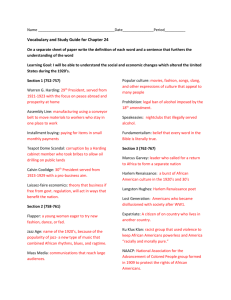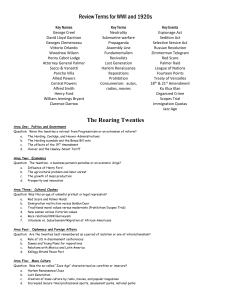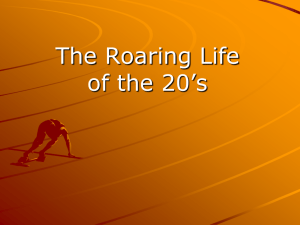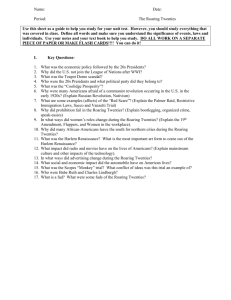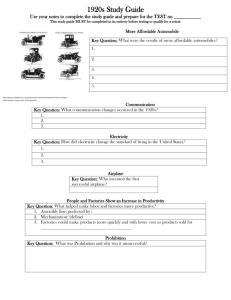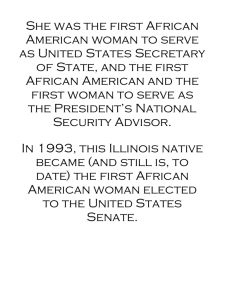Progressive - Dr. Crihfield's Website
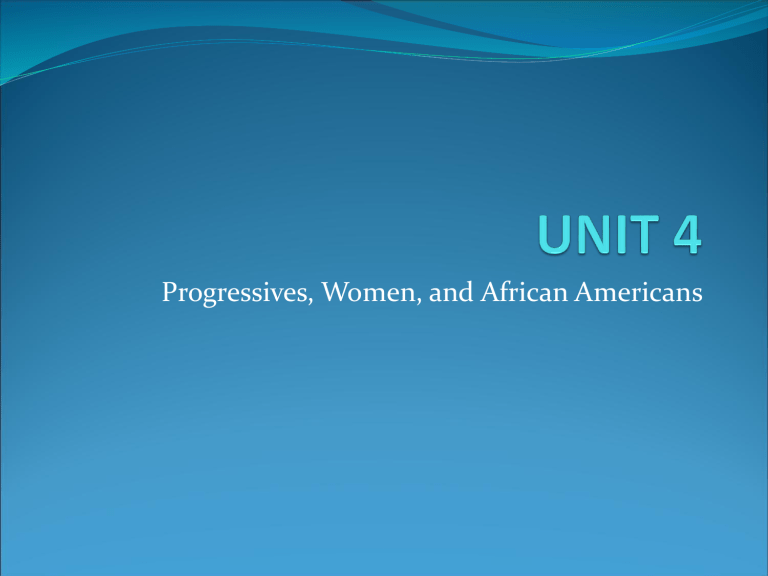
Progressives, Women, and African Americans
Progressives
“The Jungle”- Upton Sinclair
Muckraker-He took his evidence he saw and put it into a novel
The president Teddy Roosevelt reads this book in 1906 and actually creates the first laws on improving food and laws
Novel: is about conditions of immigrants working in manufacturing, conditions of the slaughterhouses, and socialism
Progressives ( continued)
Disease
Thousands of cows killed every hour
If you fell in the cooking pot, they just left you in there, because it was more meet
Bugs and feces were covering the meat
No clean water
America rips immigrants off
Forced to work in bad conditions
In pickle rooms, they stood in the brine, which ate their feet off
Progressives (continued)
Progressive- group of Americans 1910-1930 who believed in more democracy, regulation of banking and business, better education, and an informed consumer.
Who is a Progressive?
A fluent, educated, urbanite, who believed when educated they should do something about a problem.
Muckrakers: They investigate banking, corrupt businesses, lynching, insurance fraud, political machines, and political elections
Upton Sinclair
Lincoln Steffens
Jane Addams (Hull House)
Jacob Riis
Robert La Follette
Teddy Roosevelt (talked like a progressive, but wasn’t a real one)
Woodrow Wilson
Ida Tarbell
Ida Wells
Progressives (continued)
Jane Addams and Hull House:
Social relief agency funded privately
Progressives (Chart 1)
Basic Beliefs of Progressives
• People could improve society by relying on science and knowledge.
• Industrialism and urbanization caused problems.
• Government should fix problems.
• To achieve reform, government itself had to be reformed.
Government Reforms
• Commission and city-manager forms of government were adopted.
• Direct primary system let citizens choose office candidates.
• Initiative, referendum, and recall were adopted.
• Seventeenth Amendment gave voters right to elect senators directly.
• Nineteenth Amendment gave women the right to vote.
Progressives (Chart 1)
•
Business Regulation
• Interstate Commerce Commission was strengthened.
• Consumer protection laws were passed.
• Federal Trade Commission was set up to regulate business.
• Federal Reserve System was set up to control money supply.
• People could improve society by relying on science and knowledge.
• Industrialism and urbanization caused problems.
Social Reforms
• Zoning laws and building codes improved urban housing.
• Child labor laws were passed.
•Workers’ compensation laws were passed.
• Temperance movement
Progressives (Upton Sinclair)
“The Jungle”…” Conditions at the Slaughter House”
1. Everything that they had was used because they did not put anything to waste.
2. The Planters hid things that they did not want the visitors to see in the packing plants.
3. African Americans were put to hard labor hanging pigs in the slaughterhouses while trying to catch their breath.
4. The visitors were sick from the brutality of killing the hogs as they watched in the narrow hallways.
5. The slaughtering of hogs and all of the squealing and blood brought tears to the visitor’s eyes and some were clenching their fists at the sights.
6. The story shows that Upton did not like what they were doing to the pigs at the slaughterhouse, and the fact that they made people watch.
7. She wrote it to drive towards socialism.
8. It talks about the conditions that the workers had to go through, I believe It was called, “ The
Jungle”, because what the workers did was so cruel it was like they were the lions killing the pray.
9. The book persuaded President Roosevelt to change laws on food and drugs.
10. They made immigrants work in the slaughterhouses that were filled with all kinds of diseases
Sinclair. Upton.(1906). “The Jungle.” Conditions of the Slaughter House .Retrieved from
<shshistory.com>. October 26 th ,2009.
The Twenties
Movies
Rudolf Valentino (Famous movie star in a silent film)
Douglas Fairbanks
Charlie Chaplin
Lillian Gish
Flappers-
Cutting edge of young women, always have a hat and short hair, outfit very flat, plain shoes, showing all of legs but ankle
Wants to look like a young boy ( Binds her very flat)
Drinks and smokes
Dances
Going to drink illegally ( because of prohibition)
Pretend to drink tea or coffee
Dance the Charleston
Drug of choice is Cocaine ( over the counter) ; not illegal yet
This time period starts the prohibition movement
The Twenties (Continued)
Zut suit ( comes from African American cool guys)
Striped bright neon colors
Big feathered hats
Suffragette
Middle class dress
Fighting for the right to vote
Bootleggers, Mafia, Big time Crime
Start when prohibition starts
They ran alcohol from Canada, so they were not stopped by the border patrol
You were not allowed to sell it or share it, so they started making bath tub gin, so they would not get caught
It is changed with the 18 allowed to sell it th
Then it changed in the 21 st amendment which says you’re not amendment
The Twenties (Continued)
Escapism-
Want to drink alcohol, write literature, etc.
Flash Gordon ( Super hero guy in a film, “The Purple Death”) ; very
Futuristic
Famous Charlie Chaplin;
We are Anti-War now
Authors important to this Anti- War movement
Enrich Remarque, “All Quiet on the Western Front”
Ernest Hemingway,” A farewell to Arms” (American volunteers for WW1, and goes A-wall to be with his girlfriend and she becomes pregnant and they both die.
William Faulkner, very wordy and complicated
John Steinbeck,” Of Mice and Men”, “ The Red Pony”
ALL writers write about all war is bad and all men are bad
F. Scott Fitzgerald,” The Great Gatzby”, sex, drugs, rock n’ roll ( escapism of the wealthy)
The Twenties (Continued)
Era of Radio-
KDKA- in Pittsburgh is the first radio station
Impact on America:
1. Nationalizes our language
2. Gives us programming we can watch at home
Entertainment
Watch the radio ( huge mechanisms)
New immigrants during this time
Mexicans
Caribbean people
We are moving to the suburbs
Era of cars
Era of cross word puzzles
Era of Miniature golf
Era of Cards
Highest divorce rate in US history, women could also divorce
The Twenties ( Chart 2)
Cultural Changes:
• The “new morality” emphasized youth and beauty
• Young people and women gained more independence
• The working class enjoyed more leisure time
• The mass media expanded
African American Renaissance:
Harlem Renaissance
• Breakthrough period for African American arts
• Literature revealed racial pride and contempt of racism
• Jazz and blues popularized
Political Renaissance
• Great Migration created strong African American voting blocs in northern cities
• First African American elected to Congress from a northern state
• NAACP battled segregation and discrimination
The Twenties (Chart 2)
Revitalized Traditional Values:
Fundamentalists preached traditional religious values
• Emphasis on family and moral values
• Traditionalists supported Prohibition
Nativism:
• Nativists used eugenics as a pseudo-scientific basis for ethnic and religious prejudice
• The new Ku Klux Klan targeted African Americans,
Jews, Catholics, immigrants, and other groups they considered to be “un-American”
• Congress established immigration quotas
The Twenties (Pg. 603 Review)
Definitions:
Red Scare: A nation wide panic that was started because of the fear that communists or “reds” might seize power in 1919.
A. Mitchell Palmer: A United States General in
Washington D.C. whose house was damaged by one of the eight bombs in eight cities during the Red Scare.
J. Edgar Hoover: Headed the General Intelligence
Division that was established by A. Mitchell Palmer at the start of his raids.
The Twenties (Pg. 603 Review)
What conditions did African American’s face during the twenties?
They had to compete for jobs and housing
They faced racism and frustration which only led to violence
Stones were thrown at then where whites- only were allowed to go
The riots caused many African American deaths and injuries
The whites would attack there neighborhoods
The Twenties (Pg. 603 Review)
Why did Harding win the election of 1920?
He won because he called for a return to “ normalcy”
He thought the US needed to go back to the days before the progressive era reforms
What he said struck the voters resulting in the winning of the election by a landslide
The Twenties (Pg. 603 Review)
How did the Palmer raids deprive some citizens of there rights?
By detaining and deporting many suspects, disregarding the civil liberties of them
By entering homes without search warrants and mistreating people
By jailing them and not letting them speak to there attourneys
The Twenties (Pg. 603 Review)
Causes of the Red Scare:
Fear of Communists seizing power
Nation wide conspiracy
Communist International
The Twenties (Pg. 630 Review)
Definitions:
Jazz- A style of music influenced by Dixieland music and ragtime with its ragged rhythm and syncopated melodies
Blues- A soulful style of music that evolved from
African American spirituals
Great Migration- A group of hundreds of thousands of
African Americans who migrated from the rural south to the industrial cities in the north. By migrating to the north they sought to escape the segregated south society and to find new opportunities and build a better life for themselves
The Twenties (Pg. 630 Review)
Harlem Renaissance- was a result of the flowering of
African American arts. It started with the African
Americans living in Harlem, NY where they created an environment that triggered artistic development, racial pride, community and political organization. It was a start to the discovery of manyh talented writers, musicians, and leaders
Claude McKay- He was the first important writer during the Harlem Renaissance who emmigrated from Jamaica to
New York. He translated the surprise of American racism into a series of poems that was published in the Twenties.
The Twenties (Pg. 630 Review)
Langston Hughes- He was another writer, born in
Missouri, who was the leading voice of the African
American experiences in the US
Cotton Club- Was one of the most famous Harlem nightspots. It was also where Duke Ellington got his start in music
Marcus Garvey- A black leader from Jamaica who captured the immigration of many African Americans with his call for “ Negro Nationalism”. He founded the
Universal Negro Improvement Association, which was an organization that promoted black pride and unity
The Twenties (Pg. 630 Review)
Impact of the Harlem Renaissance:
Jazz, blues, and theatre
Black pride
The Twenties (Cultural Changes)
The “new morality” emphasized youth and beauty
Young people and women gained more independence
The working class enjoyed more leisure time
The mass media expanded
Era of Radio
Era of playing cards
Era of miniature golf
Era of crossword puzzles
Era of cars
We are moving to the suburbs
Highest Divorce rate in the US history ( Both men and women)
Harlem Renaissance
Definition: A renewal of arts for African Americans (1910-1930)
Literature
Dance
Music
Arts
Harlem, NY: upper middle class neighborhood, where African
Americans are moving into
Why Harlem, NY?
Great migration- move from south to north to escape segregation nd open up opportunities
Creating their own community because of segregation out of other
Communities
Center of Arts
James Weldon Johnson- Father of the Harlem Renaissance
Writer and editor
Promotes this rebirth
Harlem Renaissance (continued)
Photography:
famous photographer James Bander Zee
Blues ( makes you feel blue, slow, voice is important)
Comes from spirituals
Soulful
Jazz ( up beat, flows, all about instrument)
Billy Holiday
Ella Fitzgerald
Fats Waller
Sarah Vaughn
Louis Armstrong
Jelly roll Morton
Writers:
Langston Hughes
Claude McKay
Zora Neal Hurston
Richard Wright – “ Native Son”
Ralph Ellison- “ Invisible man”
African American Life
Red Summer- A series of racial riots ( 1919-1920)
Lynching- Hanging someone but never charged for it because people were happy they were doing that
KKK-1923’s clan grew to 5 million members because they schemed (pyramid scheme)by asking people questions and talk people into buying a patriotic rheotic and it is only 10 dollars and if you get others to join you get a part of their income
References
Appleby.J.,Brinkley.A.,Broussard.A.,McPherson.J.,&
Richie.D.(2005)The American Vision. New York,
NY. The McGraw-Hill.
Dr. Crihfield.”Public Lectures”. Retrieved the weeks
November 2009.
